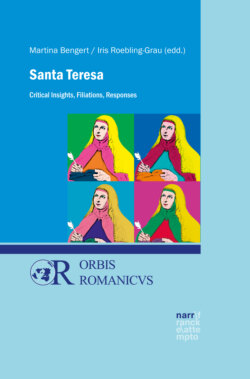Читать книгу Santa Teresa - Группа авторов - Страница 6
На сайте Литреса книга снята с продажи.
Biography
ОглавлениеThis broad and heterogeneous reception is a result of Teresa as a person as well as of her writings. The life she led has fascinated people throughout the centuries, just as her writings have impressed all kinds of readers. The present volume endeavors to shed light on the reception of Teresa of Ávila as a public figure and on her writing and its polymorphous readings. Both aspects are not identical but complement one another. In order to understand each side, it is meaningful to briefly commemorate some aspects of her life.
Her origin is already twofold. Teresa de Cepeda y Ahumada was born on March 28, 1515 in Ávila, Spain. Her father, Alonso Sánchez de Cepeda, was a noble of minor descent with a converso background. Her mother Beatrice seemed to be a passionate reader of chivalric novels. With eleven brothers and sisters, Teresa lived in a large family. When her mother died in 1528, Teresa went to a statue of Mary and asked the Mother of God to take care of her.1 According to her autobiography, this affection for Mary as a mother lasted an entire lifetime. Nonetheless, three years later, her father decided to send his daughter to the convent of the Augustins in Ávila, in order to guarantee an immaculate education and youth. Even though Teresa abided by her father’s choice, she had difficulties with the restricted monastic life and fell so seriously ill that she had to be taken out of the convent. During this period, she got to know the pious literature that left a remarkable impression on her. In 1535 Teresa decided, this time by herself, to enter into the monastery of the Carmelites in Ávila. Even though her decision was not guided by her father, she sickened again after having taken the veil in 1536. Two years later she had to leave the monastery because of this illness, and in 1539 she fell into a coma. Her recovery took a couple of years, but during this period Teresa was able to return to the Carmelite monastery of the Encarnación in Ávila where she lived among the other nuns. It was only in 1556 that Teresa had her so called ‘secondary conversion’: in front of a statue of Jesus Christ she decided to devote her life entirely to Him. During this period she started to perfect her method of inner prayer, which was accompanied by visions and mystical experiences. At the behest of her confessors, she started to write down her experiences. It was out of these writings that her autobiography, later called Libro de la vida (The Book of Her Life), emerged. Dissatisfied with the inconsistently monastery life, Teresa decided to found the first convent of the Discalced Carmelites. Out of this successful foundation emerged an entire movement of founding new convents. By the end of her life, Teresa was the first nun to have reformed an entire congregation and had established seventeen convents. This success story, unique for a woman in the sixteenth century, became one of the main characteristics of this unusual nun. Together with the serious illness, her almost miraculous recovery, and her intimate devoutness, this success story might be responsible for shaping what later became the public figure of ‘Santa Teresa’, where a perfect combination of fragility and strength, of failure and success, was at work.
This success could partially explain why Teresa was one of the first women to be included in the renowned Diccionario de la lengua española published by the Real Academia Española – unlike her comrade and pupil, Saint John of the Cross, whose poems and prose commentaries are in no way inferior to her works.2 But it is precisely the orality of Teresa’s writings that makes us believe that we are not only reading her words but also listening to her voice. It is this form of writing, her use of seemingly ordinary language that, rooted in the everyday, reaches up to the bounds of heaven to nourish a unique sense of intimacy and identification.
